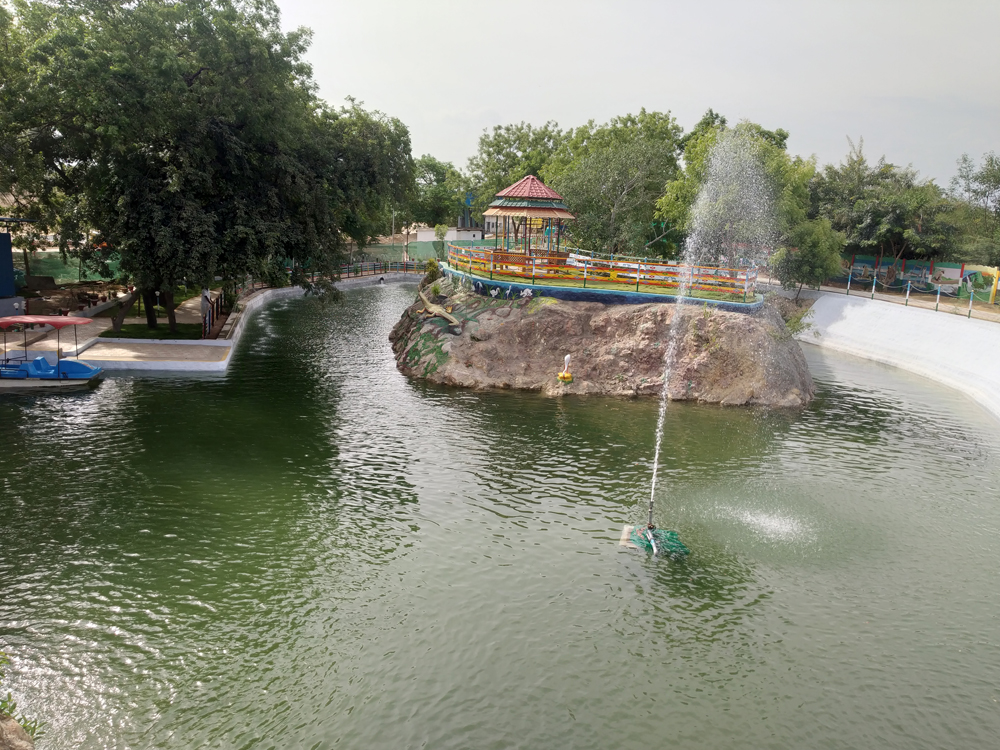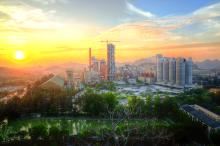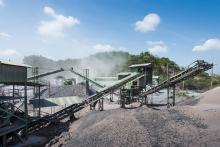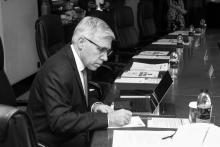
India-based Dalmia Cement has won global recognition as a pioneer of decarbonisation in the cement manufacturing sector, and is also serving as a champion of moves across all industry sectors towards zero emissions.
This has been achieved under the charismatic leadership of Mahendra Singhi, who has been CEO and managing director of the company since 2013.
He has driven Dalmia’s business philosophy that being ‘Clean and Green is Profitable and Sustainable’. The company has one of the lowest carbon footprints in the global cement sector.
One of Dalmia Cement’s core strategies is “Do not be scared of setting ambitious targets” and Singhi has spearheaded its 2018 commitment to become a carbon-negative company by 2040.
The company also claims to be the first heavy-industry-sector company to commit to a carbon-negative roadmap in 2018, and to be the only heavy-industry-sector company committed to 100% renewable energy (RE) transition by 2030. Dalmia Cement says it is the first triple joiner of business climate action groups RE100 (renewable electricity), EP100 (smart energy) and EV100 (electric vehicles) globally.
Singhi has a strong track record of tackling emissions in the cement industry head-on pre-dating his time at Dalmia. He has worked in the cement sector for more than 40 years, and was previously at Shree Cement where he served for 20 years and was CEO. Shree was adjudged as New Sustainability Champion by the World Economic Forum during his tenure in 2012.
He has represented the business and cement sector globally in the most recognised multi-country platforms such as the United Nations Climate Ambition Summit in December 2020, and the Climate Action Summit of the UN General Assembly in September 2019.
Dalmia is India’s fourth-largest cement company with 30.7 million tonnes annual production capacity, and has won a range of accolades both in India and internationally that testify to the success of its innovative efforts in driving industry sustainability.
It is one of the five global climate defenders identified by BBC World, and was ranked number one in 2019 by environmental charity the Carbon Disclosure Project (CDP) in the global cement sector in terms of business-readiness for a low-carbon-economy transition.
The fact that all this has been achieved in a country with the second-highest carbon footprint after China makes it all the more impressive.
“The whole aim was to serve a larger purpose and to serve society at large,” Mahendra Singhi explains. “Eight years ago, we created our strategy where we said that we want to be the leader in building materials and to involve pride in all stakeholders through sustainability, innovation and values.
“For that reason, we started our journey on sustainability. We understood that if we take certain actions in our cement process then we can be cleaner and greener and bring down the cost of production, and at the same time we can be more sustainable which means using less power, less fuel, less mineral resources and less water.”
He says that this philosophy has helped to create the right mindset in all the company’s employees, including the board, and once this philosophy was accepted it could start taking actions.
One of the major actions Dalmia took was to start measuring its carbon footprint from full-year 2014. It was found that, although far better than many other manufacturers, this was still quite high and the company was emitting 670kg of CO2 per tonne of cementitious material.
Dalmia then decided to take a number of further actions to reduce its CO2 emissions, while at the same time increasing its profitability. The actions mainly include:
- Conservation of natural resources by enhanced use of industrial wastes as alternative raw materials and alternative fuels
- Thermal and electrical energy efficiency
- Use of state-of-art technologies in new plants
- Strategic acquisitions to use more industrial wastes as raw materials
“We took these actions for four years and based on that our carbon footprint reduced to 546kg per tonne by full-year 2019, which was one of the lowest in the global cement industry,” Singhi says. “We were able to prove to the whole world that because of our lower carbon footprint our profitability has gone up.
“We have been able to decouple our emissions from growth. Compared to the 1990 baseline, Dalmia reduced its carbon footprint by 40% and the bulk of it, about 26%, has happened in the past seven years. As of full-year 2021, our carbon footprints are 492kg per tonne of cementitious material.”
Dalmia is a member of the Cement Sustainability Initiative (CSI) set up by the major cement companies to facilitate sustainable development of the cement and concrete sectors and their value chains.
“Even though we were quite small compared to them, we were part of the initiatives because of our policies and philosophy,” Singhi says.
Dalmia uses waste products such as fly ash from concrete production or slag from steel plants as part of its decarbonisation efforts. Singhi says this generates electric power from the waste gases which both lowers the company’s carbon footprint and also reduces its costs for materials, power and fuel. Dalmia has also brought down the amount of clinker it uses in cement.
Singhi says the company became one of the lowest carbon-footprint manufacturers in the cement sector in 2018, and the question was then ‘What next?’
“The culture in our organisation is to visualise the future and act today,” he says. “We decided to take a few more steps to make our carbon footprint zero.”
We were the first cement manufacturing company in the world to declare our commitment to become carbon negative by 2040,” says Singhi. “People initially started laughing at us, but then the message began spreading that there are companies like Dalmia Cement that are thinking that big.”
Singhi says the 2040 target is achievable as the world is moving towards net-zero targets at economic scale that have never been seen before, adding that Dalmia is on track for its roadmap and making the right progress.
He adds that there are still challenges that need to be resolved such as carbon markets, green grants, green finance and green premiums for green products. “The way policy and technology development is taking shape, I am confident these barriers will also go away or be eliminated in the time to come,” he says.
Dalmia Cement started sharing its belief with organisations globally that it could become carbon negative through the use of a number of levers. The first of these was to use 100% renewable energy by 2030. The second was to completely replace the use of fossil fuel in cement kilns by 2035 with biomass matter such as bamboo grown on plantations near to its cement plants, hazardous waste hydrogen and municipal solid waste.
The company has put an emphasis on low-carbon, blended cement production and by 2025, it should transition into a 100% blended cement producing company as against 80-85% today. Dalmia has also started EV transition and committed to switch its significant fleet to electric vehicles while following the business philosophy of ‘Clean and Green is Profitable and Sustainable’.
Dalmia states that as well as being renewable, such biomass materials create carbon sinks in soil and below ground and help rejuvenate wastelands.
The bamboo planting is to take place on wasteland around the 14 cement plants that Dalmia operates in India.
“We are a huge country and have around 26 million hectares of wasteland,” says Singhi. “In the time to come the government will give us this land and we will start planting trees. This will be a very important action for creating sustainability and will also generate employment around the country.”
Dalmia Cement plans to increase its current 31 million tonnes annual production capacity to 50 million tonnes by 2024.
“Many Indian cement companies are doing a good job in their sustainability efforts, and I would also say that many are following what we are doing,” says Singhi.
“We are also innovating by employing CCU (carbon capture and utilisation) technologies and using carbon as a raw material for products including concrete, fertiliser and protein. CCU is the vaccine for the climate crisis and without it the cement sector can only decarbonise by around 40%. To decarbonise by 100%, we need CCU.”
He adds that green hydrogen as a fuel may also play a big role in decarbonisation where it could have dual use as a reduction agent and as a clean fuel source in industries including cement and steel.
In September 2019 Dalmia announced it was to build a large-scale facility to enable 500,000 tonnes per year of carbon capture at its cement plant at Tamil Nadu. It signed a memorandum of understanding with Carbon Clean Solutions Limited (CCSL), a UK-based company that supplies low-cost carbon dioxide (CO2) separation technology to provide technology and operational services for the plant based on its patented CDRMax technology. The project has been assessed by the Asian Development Bank, and Singhi says Dalmia will shortly be approaching the US government to support the project.

Dalmia owns many limestone quarries, adjacent to its 14 cement plants across India. The plants are very large with annual capacities of three to five million tonnes per annum and need a large quantity of limestone. Singhi says Dalmia is exploring the possibilities of how captured CO2 can be used for producing aggregates suitable for construction.
The company is also working on various energy-efficiency projects such as carbon sequestration and the adoption of other advanced green technologies by 2040.
The United Nations invited Dalmia to its Climate Action Summit in New York in 2019 to tell delegates about its ‘Clean and Green is Profitable and Sustainable’ philosophy, where it was one of the very few industrial companies speaking.
Singhi says the concept of the net-zero economy has started taking effect following the summit: “In 2018 nobody was talking of a net-zero carbon economy, but slowly companies and countries started thinking about it. We try and share our knowledge on each and every global platform, whether it’s the UN, World Bank or any other organisation which is talking of climate change. These organisations are keen to move the conversation around the global cement sector from being hard to abate to possible to abate.”
In terms of Dalmia’s growth prospects in India, Singhi says these are very strong with the government investing over the last year to create employment, infrastructure and provide momentum to industry. He adds that the country will have the fastest-growing gross domestic product (GDP) in the world within two years, driven by government investment and an increase in people’s incomes due to more business and economic activity.
“At the moment cement production in India is only 210kg per capita compared to the global average of 500kg, and the average in China is around 1,400kg per capita,” says Singhi. “The scope for India to go from 210kg to 500kg is great.”
In June this year Singhi was invited to represent the World Bank-promoted Carbon Pricing Leadership Coalition (CPLC) as its carbon-pricing champion, where he will work with global business leaders to devise pricing strategies for the Asia-Pacific region.
CPLC is a voluntary global coalition represented by 34 national and sub-national governments, 172 private sector organisations, 100 strategic partners non-governmental organisations (NGOs), business organisations and universities.
It aims to combat climate change by securing the place of carbon pricing on the global agenda. Singhi was commended by CPLC board members for demonstrating leadership and a high level of commitment towards carbon pricing on behalf of Dalmia Cement. The members expressed the desire to get more strategic input from him in the future.
He will work with business leaders like Feike Sijbesma, honourary chair of the board of Royal DSM, to devise the carbon-pricing strategies for the Asia-Pacific region.
The CPLC encourages and brings together leaders from government, business, academia and civil society to address various issues related to climate change.
Singhi says he aims to raise awareness about carbon pricing in his CPLC role: “At the moment carbon pricing is present in Europe, to some extent in the USA, and in Japan, but not in other Asian countries. I want to create awareness about carbon pricing and to motivate companies about taking actions so that we can take care of present and future generations.”
In further recognition of his efforts, Singhi was also appointed as a new director of the World Cement Association along with Roland van Wijnen, CEO of Africa’s PPC.
“I am very grateful to the WCA for inviting me onto their board,” says Singhi. “We discussed the issue of net-zero emissions and the WCA created a net-zero carbon steering committee so that we can create awareness on the issue among all WCA members.”
He adds that Dalmia’s activities and ambitions regarding decarbonisation are motivating many members at the WCA.
“The efforts of the WCA and in particular its CEO Ian Riley are centred on how we can work on new technologies and clean climate technologies so that the knowledge of everyone gets shared,” he says.
“Nigel Topping, who is the High Level Climate Action Champion for the COP26 climate talks, spoke to us about why there is a need for net -zero carbon, and I think this will make a very big impact on other WCA cement company members in terms of their commitment to net-zero carbon. He said that myself and Dalmia Cement are not only working for the cement sector but for industry globally.”
Singhi says Dalmia openly shares knowledge with other companies on how it uses the right technologies and how it brings down its energy and heat consumption. The company is now associated with 17 associations both in India and globally where this knowledge is shared, including the UN-backed initiative Industry Transition which is led by India and Sweden.
The leadership group of Industry Transition gathers countries and companies that are committed to action to achieve the Paris Agreement. It was launched by the governments of Sweden and India at the UN Climate Action Summit in September 2019 and is supported by the World Economic Forum.
“We are one of eleven global business partners of Industry Transition and share our knowledge of how it is beneficial for industry to move from the carbon economy to a net-zero carbon economy,” says Singhi.
He adds that the Indian government is “very supportive” of companies increasing their activities to combat climate change. India has set a target of generating 450gw of electricity from renewable energy such as solar and wind power by 2030, which Singhi says is the biggest target set by any country in the world.
Dalmia has also set the target of having all-electric cars and trucks by 2030, and will advise its supply chain companies to also use electric vehicles.
Asked how he would describe his leadership style, Singhi – a Science & Law graduate and qualified chartered accountant – responds: “First of all, it’s trusting the people. People are the most important assets for me, the company and the country. Secondly, work for happiness. The philosophy I have is to be happy and make others happy.
“I also want to take out the fear of failure from the minds of the people. Normally I say: ‘Success is yours; failure is mine.’”

Dalmia’s trading strategy is to grow more and market its green products to be used in building and construction. Singhi says the company aims to be the most efficient cement company in terms of its operations, and provide green products that give value for money.
“Over the last 15 years we have gone from being a 1.5 million tonnes a year company to producing 31 million tonnes with the growth prospect to reach 50 million tonnes by 2024,” he adds.
“Another strategy is to keep our own people happy and give them pride. If they are working for a company that has a greater purpose of also serving society, they will feel happy. We maintain that we are not only producing cement but we are helping the people to construct their house, and we are helping society to construct infrastructure. I look on cement as a happiness material. Once you construct your house you become happy.”
In terms of ambitions outside India, he says the main aim is to provide the leadership for green climate actions, with no plans at the moment for supplying cement outside of India.
“We have very great growth potential in India itself,” he states. “We are limiting ourselves at the moment and using Indian resources, Indian mines, and growing in India itself. All our raw material comes from Indian quarries and companies.”
Looking back over his 40 years in the cement industry, Singhi says it has been an exciting time. What have been the biggest changes during this period?
“The change in the speed of transformation itself is the most exciting part of it today. Earlier there would be major changes in the industry over a decade, but today even 2-3 years can make a big difference in terms of technological change with IT, blockchain, AI and so many other things.”










